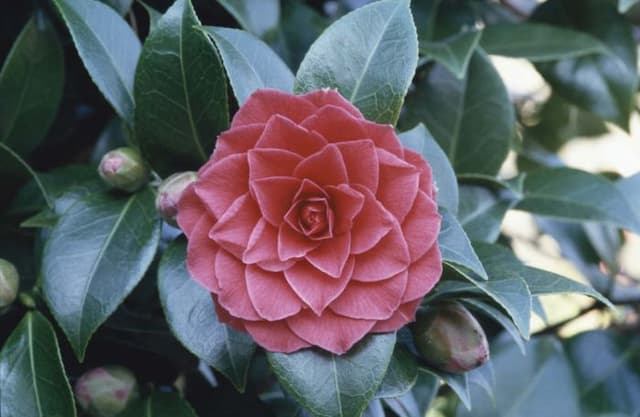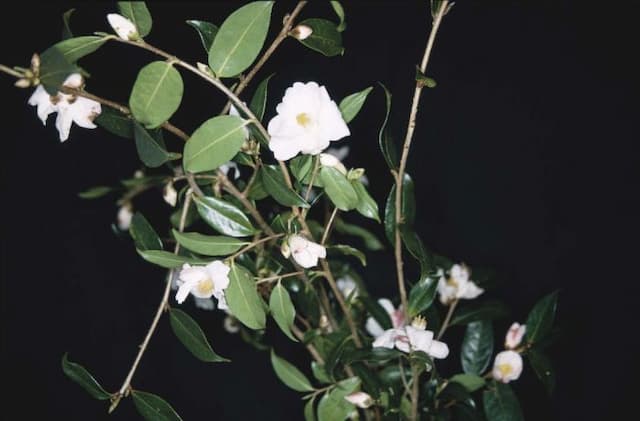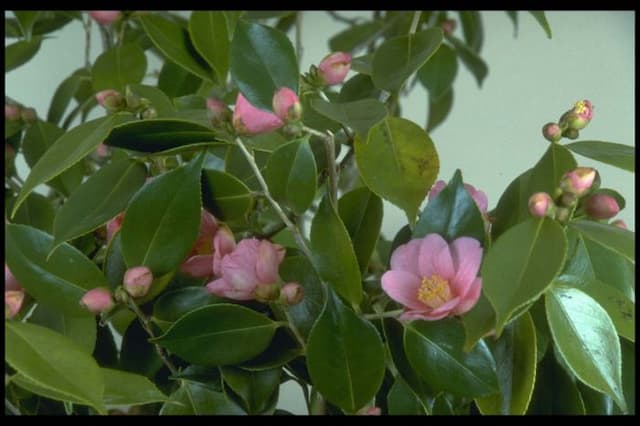Sasanqua Camellia Camellia sasanqua 'Rosea'

ABOUT
The Camellia sasanqua 'Rosea', commonly known as Sasanqua camellia, boasts a lush and elegant appearance. This particular variety is adorned with rose-pink flowers that create a striking contrast against the glossy, dark green leaves. As the plant blooms, the flowers reveal a simple yet graceful form, often with petals that are slightly ruffled at the edges, adding to their charm. Each flower of the Sasanqua camellia has a central cluster of bright yellow stamens, which stands out against the delicate pink of the petals. The blooms are moderately sized and can appear in abundance, giving the plant a picturesque and bountiful look during its flowering season. The leaves of the Sasanqua camellia are leathery to the touch and have a slightly serrated edge, contributing to its overall sophisticated texture. The growth habit of the plant tends to be dense and well-branched, lending itself to a full-bodied appearance that's both neat and aesthetically pleasing. The Sasanqua camellia can often be observed as a shape that is pleasing to the eye, either naturally or with the help of pruning to maintain its form. Its lush foliage and vibrant blooms add to the allure and make it a favored choice for ornamental displays in gardens and landscapes.
About this plant
 Names
NamesSynonyms
Sasanqua Camellia, Christmas Camellia, Yuletide Camellia.
Common names
Camellia sasanqua 'Rosea'.
 Toxicity
ToxicityTo humans
The plant commonly known as Sasanqua Camellia is not considered toxic to humans. Generally, it is safe to handle and does not produce toxic effects if ingested. Like many plants, however, individual allergies or sensitivities are possible. Ingesting any plant material may cause mild stomach upset due to the presence of unusual compounds the human body is not accustomed to digesting.
To pets
Sasanqua Camellia is also non-toxic to pets such as dogs and cats. It is not known to cause any serious symptoms of poisoning if pets ingest the leaves or flowers. While it is unlikely to cause harm, ingestion of any plant material can potentially lead to gastrointestinal irritation or upset, so monitoring your pet and keeping plants out of their reach is always a prudent measure.
 Characteristics
CharacteristicsLife cycle
Perennials
Foliage type
Evergreen
Color of leaves
Green
Flower color
Pink
Height
4-6 feet (1.2-1.8 meters)
Spread
4-6 feet (1.2-1.8 meters)
Plant type
Shrub
Hardiness zones
7
Native area
Japan
Benefits
 General Benefits
General Benefits- Ornamental Appeal: Sasanqua camellia produces attractive pink blooms that enhance garden aesthetics.
- Long Blooming Season: It blooms in the fall and winter, providing color during a time when few other plants are in bloom.
- Drought Tolerance: Once established, it has a level of tolerance to dry conditions, reducing the need for frequent watering.
- Shade Tolerance: The plant can thrive in partial shade, making it suitable for understory planting.
- Habitat Support: The flowers provide nectar for pollinators such as bees during the cooler months.
- Versatility in Landscaping: Can be used for hedges, screens, or as a specimen plant, offering flexibility in garden design.
- Fall and Winter Interest: Adds visual interest to the garden during seasons with less floral abundance.
- Evergreen Foliage: The plant retains its leaves year-round, providing constant greenery and structure.
- Low Maintenance: Requires minimal pruning and care once established, making it a convenient choice for gardeners of all levels.
- Disease and Pest Resistance: Generally resistant to many common plant diseases and pests, ensuring longevity and vigor.
 Medical Properties
Medical PropertiesThis plant is not used for medical purposes.
 Air-purifying Qualities
Air-purifying QualitiesThis plant is not specifically known for air purifying qualities.
 Other Uses
Other Uses- Sasanqua camellia petals can be used to create a natural dye for fabrics, imparting a delicate color depending on the petal's hue.
- The leaves of the Sasanqua camellia can be used in the art of Kokedama, where they can become an outer wrapping for the moss ball to add aesthetic variation.
- Cold-pressed oil from the seeds of Sasanqua camellia, also known as Tsubaki oil, can be used as a natural lubricant for tools and machinery.
- Florists may incorporate dried Sasanqua camellia flowers into potpourri for their color and shape, contributing to the visual appeal of the mix.
- The wood of the Sasanqua camellia can be carved into small decorative items or utensils, valued for its smooth texture and grain.
- Sasanqua camellia leaves can be used as a natural insect repellent, with their essential oils deterring certain pests when scattered around outdoor areas.
- Dried petals of the Sasanqua camellia can be included in handmade paper, adding botanical elements and uniqueness to the final product.
- The flowering plant can be used for bonsai, admired for its aesthetic traits, and the challenge it presents to the grower to maintain its miniature form.
- The petals of Sasanqua camellia can be used to adorn salads or as an edible decoration on desserts, introducing an unexpected floral element to culinary presentations.
- Sasanqua camellia blooms may serve as organic confetti for outdoor events such as weddings, providing an eco-friendly alternative to synthetic confetti.
Interesting Facts
 Feng Shui
Feng ShuiThe Sasanqua Camellia is not used in Feng Shui practice.
 Zodiac Sign Compitability
Zodiac Sign CompitabilityThe Sasanqua Camellia is not used in astrology practice.
 Plant Symbolism
Plant Symbolism- Love and Affection: Camellias often symbolize love, affection, and admiration, making them a popular gift for loved ones.
- Longevity and Endurance: The camellia's ability to bloom in cooler seasons is often seen as a symbol of endurance and the ability to thrive despite challenges.
- Perfection and Excellence: With its flawless petals and overall beauty, the camellia can represent the pursuit of perfection and excellence in various aspects of life.
- Gratitude: Giving a camellia is a way of expressing gratitude, as the flower is historically linked to acts of thankfulness and appreciation.
- Admiration: Particularly, the pink camellia 'Rosea' symbolizes a longing or longing for someone, often given to show one's admiration of another person.
 Water
WaterSasanqua camellias should be watered deeply to establish a healthy root system—typically about 1-2 gallons per week during the first growing season. Adjust the frequency to be less often in cooler months or if rainfall is adequate, aiming for about once a week. Water thoroughly until the soil is moist but not saturated. Never let the plant sit in water, as this could lead to root rot. It's best to water the camellia in the morning to allow any excess moisture on the foliage to dry before the cooler evening temperatures.
 Light
LightSasanqua camellias thrive in partial shade with filtered sunlight. They do well with morning light and afternoon shade, which helps protect the foliage and blossoms from the harsh midday sun. The ideal location would be under the canopy of tall trees that provide dappled sunlight, avoiding prolonged exposure to full sun, which can cause leaf scorch.
 Temperature
TemperatureSasanqua camellias prefer a temperate climate with temperatures ranging from 40 to 85 degrees Fahrenheit. They can withstand minimum temperatures down to about 20 degrees Fahrenheit but may suffer if temperatures dip below this threshold. Ideal growth is achieved in an environment that does not consistently exceed the upper end of their temperature range or fall below the minimum.
 Pruning
PruningSasanqua camellias should be pruned to maintain shape, remove dead or weak wood, and encourage airflow which prevents disease. Prune right after they finish blooming, typically in late winter or early spring before the new growth begins. It's not necessary to prune every year—only when shaping is required or to remove inner branches that are overcrowding the plant.
 Cleaning
CleaningAs needed
 Soil
SoilThe best soil mix for a Sasanqua Camellia, commonly known as Sasanqua Camellia 'Rosea', is well-draining, rich in organic matter, and slightly acidic with a pH of 5.5 to 6.5. A mix containing equal parts of peat moss, pine bark, and coarse sand or perlite is ideal for ensuring good drainage and the right acidity.
 Repotting
RepottingSasanqua Camellias should be repotted every 2-3 years to prevent them from becoming root-bound and to replenish the soil nutrients. The best time to repot these plants is in the late winter or early spring before the onset of new growth.
 Humidity & Misting
Humidity & MistingSasanqua Camellias prefer moderate to high humidity levels, ideally between 50% to 70%. They thrive in environments that mimic their native humid habitats, so maintaining consistent humidity is crucial for their well-being.
 Suitable locations
Suitable locationsIndoor
Ensure bright, indirect light and regular watering.
Outdoor
Plant in partial shade, protect from strong winds.
Hardiness zone
7-9 USDA
 Life cycle
Life cycleThe life cycle of the Camellia sasanqua 'Rosea', commonly known as Sasanqua Camellia, begins with seed germination, occurring in a warm, moist environment typically in spring. Following germination, the seedling undergoes vegetative growth, developing a root system and foliage through juvenile stages. As the plant matures, it enters the adult phase, characterized by the development of buds that will become the distinctive pink flowers, usually blooming in the fall to early winter. After pollination, which is often facilitated by insects, the flowers produce seeds in the form of a dry capsule, completing the reproductive cycle. Once mature seeds are dispersed, they can give rise to new plants, thereby continuing the species' life cycle. The plant may also be propagated vegetatively through cuttings, bypassing the seed stage for more controlled cultivation.
 Propogation
PropogationPropogation time
Fall-Winter
The most popular method of propagation for the Camellia sasanqua 'Rosea', commonly known as Sasanqua camellia, is through semi-hardwood cuttings. This technique is typically done in late summer, after the spring growth has matured and begun to harden. To propagate, cut a 4 to 6-inch (approximately 10 to 15 centimeters) length of semi-hardwood stem that includes several leaves. The lower leaves should be removed, and the cut end of the stem is then dipped in rooting hormone to encourage root development. The prepared cutting is inserted into a pot filled with a well-draining soil mixture, ensuring that at least two nodes where leaves were removed are buried in the soil. The pot is then placed in a warm, humid environment with indirect light, and kept moist but not waterlogged. Roots typically develop within a few months, after which the new camellia plant can be gradually acclimated to outdoor conditions and eventually planted in its permanent location.









